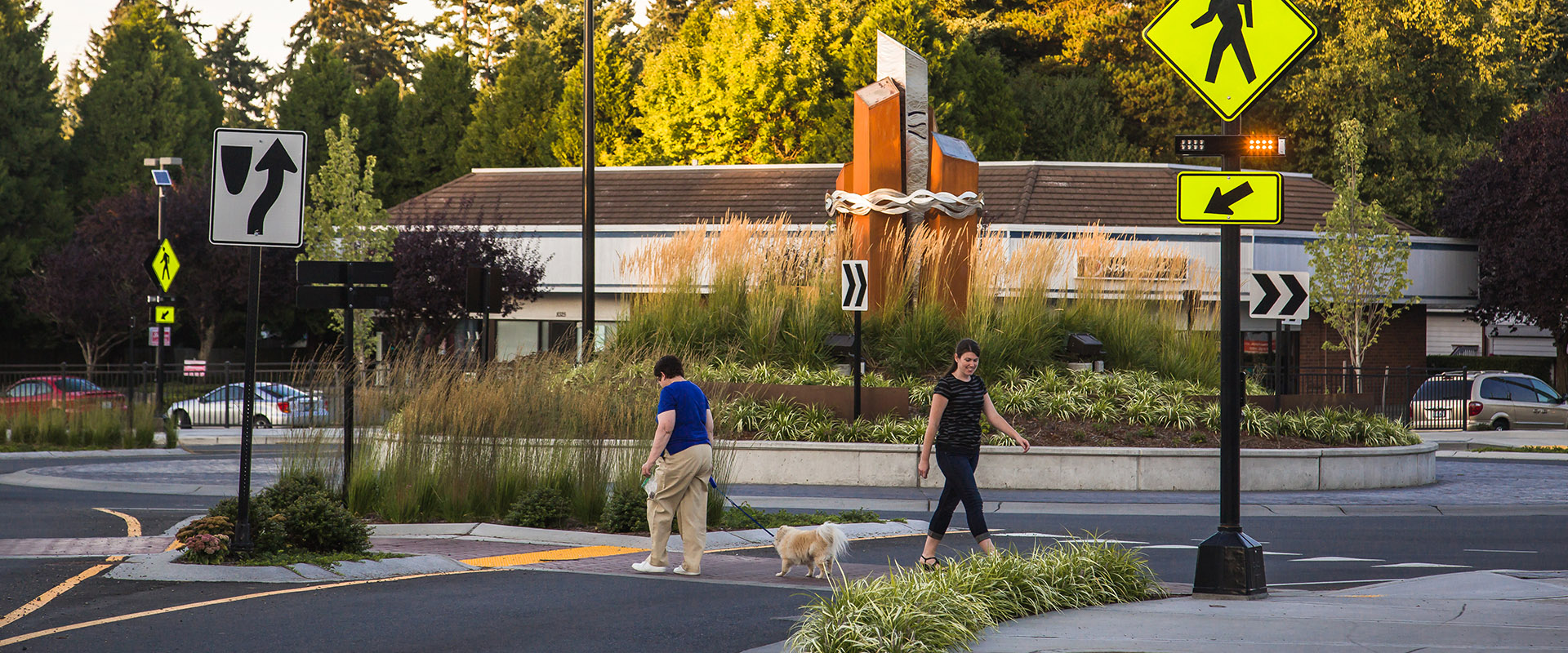Summary of RRFB cost and effectiveness
- An FHWA study shows RRFBs are proven to reduce crashes involving pedestrians by up to 47% (3).
- An FHWA study shows RRFBs consistently deliver impressive driver yielding rates of up to 96% (12).
- RRFB Crash Modification Factor: 0.53 for vehicle-pedestrian crashes in urban and suburban areas (11).
- The cost to furnish and install an RRFB can vary depending on site conditions and the type of RRFB used. Average treatment cost for an RRFB complete system is $22,250 including installation, labor, and materials (9).
| Crash modification factor (CMF) | Driver yield rates | Average price (including installation, labor, and materials) |
| 0.53 for vehicle-pedestrian crashes in urban and suburban areas | 73-96% driver yield rate with RRFBs | $22,250 |
We all want safer streets.
Never has road safety been a more pressing need as US pedestrian deaths reach a 28-year all-time high.
A 2018 Governors Highway Safety Association (GHSA) report identifies several factors, listed below, which have led to a 35% increase in pedestrian deaths within the past 10 years (1).
“The alarm bells continue to sound on this issue,” said GHSA Executive Director Jonathan Adkins. “It’s clear we need to fortify our collective efforts to protect pedestrians and reverse the trend” (2).
Here, the GHSA explains the leading causes behind the rise in pedestrian fatalities (1):
- More people are walking; an estimated number of Americans walking to work increased about 4% between 2007 and 2016.
- Most pedestrian fatalities take place on local roads at night, away from intersections. Within the past 10 years, nighttime crashes accounted for more than 90% of the total increase in pedestrian deaths.
- Speeding, distracted driving and drowsy drivers and alcohol impairment by driver and pedestrian contributed to about half of incidents causing pedestrian fatalities in 2017.
- The number of sport utility vehicles involved in pedestrian deaths has increased by 50% since 2013; by 30% involving passenger cars within the same time period.
DRIVER YIELD RATES AT A MID-BLOCK CROSSWALK

RRFBs: the leading crosswalk safety device
Recent studies verify, of the top three safety beacons, the rectangular rapid flashing beacon (RRFB) ranks as the most effective and cost-efficient crosswalk device on the market today. Tests prove the RRFB can heighten driver yield rates by up to 96% and reduce pedestrian crashes by 47% (3).
How RRFBs work
Installed at unsignalized intersections, mid-block crossings or roundabouts, RRFBs can be attached to poles of existing crosswalk signage. Beacons are synchronized to flash on either side of the road when activated by the pedestrian prior to entering the crosswalk. Studies find two beacons work well, however, safety margins improve with four or more RRFBs on roadways with heavy traffic or higher speed limits with multiple lanes (7).
RRFB design exploits the electroluminescence of high-intensity LEDs, adjusted at heights to capture drivers’ awareness day and night and from greater distances, out-performing traditional crosswalk warning lights.
The RRFB has a highly visible flash pattern with an ultra-bright, amber light that delivers a quick, irregular ‘wig-wag’ flash, similar to lights on emergency response vehicles. Drivers react sooner at the sight of a flashing RRFB, even under challenging conditions such as inclement weather, headlight glare, and limited visibility.
RRFBs out-perform other crosswalk beacons
From the first Federal Highways Administration (FHWA) study in 2010 on a mid-block crosswalk in Florida through to studies conducted within the last nine years, the RRFB yield rate performs consistently better than alternate safety beacons by more than 75%.
Further, the FHWA’s 2019 Safe Transportation for Every Pedestrian initiative placed the RRFB first in its “Spectacular Seven” ranking of top-performing safety treatments for having reduced pedestrian crashes up to 47% (4).
Now free of patent protection issues, the RRFB is permitted for use by the Manual on Uniform Traffic Control Devices (MUTCD) with Interim Approval (IA-21). Also, RRFBs are a lower-cost alternative to traffic signals and pedestrian hybrid signals, according to the FHWA (3).
This four-minute video explains how RRFBs work, why they’re so effective, and where best to install at your crosswalk.
What about other crosswalk treatments?
Next, we’ll look at other popular crosswalk treatment options and compare their effects on pedestrian crashes, driver yield rates, and their costs.
Circular flashing beacons

Circular beacons feature pedestrian-activated, high-intensity amber warning lights, that notify drivers when a pedestrian is entering a crosswalk, in a slower, alternating flash pattern.
Like RRFBs, these beacons can be used to supplement crosswalk signs at marked, uncontrolled crosswalks, including urban mid-block crosswalks, trail crossings, roundabouts, and other pedestrian walkways.
FHWA research shows that installing a marked crosswalk without flashing beacons will not necessarily result in vehicles stopping for pedestrians. For safer crosswalks, consider the addition of flashing warning beacons to crosswalk treatments (3).
Summary of circular flashing beacon costs and effectiveness
- Circular flashing beacons can increase driver yielding rates up to 73% and higher (9).
- The cost to furnish and install a flashing beacon varies based on site conditions and the type used. Average treatment costs are $10,010 (12).
| Driver yield rates | Average price (including installation, labor, and materials) |
| 73% and higher | $10,010 |
In-pavement lighting systems

Also known as in-roadway warning lights (IRWL), these treatments alert motorists to pedestrians crossing at uncontrolled locations. Both sides of the crosswalk are lined with encased raised lights set level with the asphalt, some with LED strobe lighting, and facing towards the driver.
When pedestrians enter a crosswalk and the in-pavement lighting system is activated, research shows motorists’ speeds declined. The rate of yielding became less over time in some cases as drivers became more familiar with this crosswalk treatment.
Studies show speed and yielding rates vary widely across installations. Short-term improvements in yielding rates have been reported and are generally greater at nighttime, yet in all, these improvements still reduce over time.
Damage and malfunction issues with the lighting also remain a drawback. Several jurisdictions are removing in-pavement lighting systems due to unreliability, maintenance costs and ineffectiveness compared with other safety beacons. Also, drivers struggle to see the devices in daylight and the lights are also difficult to see when following other drivers.
Summary of IRWL costs and effectiveness
- Crash Modification Factor: 0.58 for pedestrian nighttime crashes (11).
- The cost of in-pavement lighting systems varies depending on the manufacturer, roadway widths and project-specific installation factors. Usually, in-pavement lights are installed as a complete system with an average treatment cost of $17,620 (9).
| Crash modification factor (CMF) | Average price (including installation, labor, and materials) |
| 0.58 for pedestrian nighttime crashes | $17,620 |
Pedestrian Hybrid Beacons (PHBs)

This traffic control device is designed to increase motorists’ awareness of pedestrians crossing at an uncontrolled marked crosswalk. The PHB* can only be activated by pedestrians when needed. PHBs are becoming increasingly popular with State and local transportation agencies and are useful in areas with limited yielding rates.
The PHB has significantly reduced pedestrian crashes by 69%, as published in a 2010 FHWA study. PHBs remain dark until activated which helps increase driver attention and can also reduce rear-end collisions (6).
Its red signal clearly indicates drivers must stop and allow pedestrians to cross. Compliance to yield exceeded 90% (2).
* Also known as HAWKs (High-intensity Activated crossWalK beacons). In Europe, they are known as PELICAN pedestrian signals.
How PHBs work
This beacon is designed for mid-block crossing locations and is push-button activated by pedestrians as needed. The design consists of two horizontal red lights above a single yellow light. A brief flashing yellow interval is followed by a steady yellow interval, then by a steady red signal indicating motorists to stop. A Walk sign is lit to notify pedestrians to cross the roadway.
Summary of PHB costs and effectiveness
- Crash Modification Factor: 0.45 (11).
- PHBs are typically more expensive to implement and maintain than RRFBs, though are less expensive than full traffic signals (10).
- Average treatment costs for PHBs are $57,680 including three signal sections, overhead pedestrian crosswalk signs, pedestrian detectors, and countdown pedestrian signal heads (10).
- FHWA’s 2019 Safe Transportation for Every Pedestrian initiative placed the PHB sixth in its “Spectacular Seven” ranking of top-performing safety treatments for having reduced pedestrian crashes by up to 55% and by improving driver yielding rates to more than 90% (4).
| Crash modification factor (CMF) | Driver yield rates | Average price (including installation, labor, and materials) |
| 0.45 for vehicle-pedestrian crashes in urban and suburban areas | 90+% driver yield rate with PHBs | $57,680 |
Who’s watching the roads? We are.

Designing and building highly-efficient solar or AC-powered beacons to maximize pedestrian safety within crosswalks is what we do at Carmanah Traffic.
We work closely with urban planners and traffic engineers to create sustainable, reliable traffic solutions that consider the needs of everyone on the road today including the driver, the pedestrian, the cyclist, among others.
Carmanah Traffic has a history of helping clients make the right safety decisions for their roads and intersections, plus we meet all MUTCD regulations, ITE requirements, and other essential specifications across North America.
Questions? Please contact us.
References
- Governors Highway Safety Association – Spotlight on Safety – Pedestrian Fatalities by State. (2019).
- Governors Highway Safety Association – Spotlight on Safety report on key findings – news release. (2019).
- Federal Highway Administration– Evaluation of Pedestrian Hybrid Beacons and Rapid Flashing Beacon – report. (2016) (PDF).
- US Department of Transportation: Sept – Oct Innovator newsletter – States Step up to Enhance Pedestrian Safety, Spectacular Seven. (2019).
- Transportation Research Board – An Analysis of the Effects of Stutter Flash LED Beacons to Increase Yielding to Pedestrians Using Multilane Crosswalks. (2009). RRFB
- Federal Highway Administration – Case Study: Pedestrian Hybrid Beacon Guide. Washington, D.C. (2014).
- Federal Highway Administration – Guide for Improving Pedestrian Safety at Uncontrolled Crossing Locations. Washington, D.C. (2018).
- Transportation Research Board – The National Academies of Sciences, Engineering, Medicine – Application of Pedestrian Crossing Treatments for Streets and Highways. Washington, D.C. (2016).
- Transportation Research Board – The National Academies of Sciences, Engineering, Medicine – Costs for Pedestrian and Bicyclist Infrastructure Improvements, A resource for researchers, engineers, planners and the general public. Washington, D.C. (2013).
- Federal Highway Administration – PEDSAFE 2013 – Pedestrian Safety Guide and Countermeasure Selection System – Washington, D.C. (2013).
Proven Safety Countermeasures – Pedestrian Hybrid Beacons - Federal Highway Administration – The National Academies of Sciences, Engineering, Medicine – Crash Modification Factors Clearinghouse – Study Details for Uncontrolled Pedestrian Crossing Treatments. (2017).
- Federal Highway Administration – Effects of Yellow Rectangular Rapid-Flashing Beacons on Yielding Multilane Uncontrolled Crosswalks. (2010).

